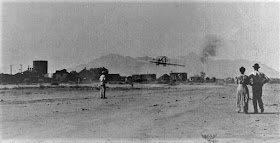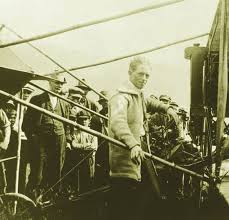I am impressed with the level of cupidity among the participants in this amazing air race. (It means they were avaricious.) Certainly the pilots, Bob Fowler and Cal Rodgers, were risking their lives day after day and deserved some reward for that risk. And now that the prize which had inspired it all had been withdrawn, they had to work even harder for it. At Dallas, where Cal Rodgers stopped on the Tuesday night of 17 October, and at Fort Worth, where Cal put in two days of flights before 75,000 at the state fair, he sold photo’s and autographs, as Bob Fowler did at his stops - just as musicians do today at concerts. And there were always the “Vin Fiz” coupons Cal was still dropping over unsuspecting soda drinkers in cities where he did not land. The Waco Texas Young Men’s Business League offered Cal an impressive fee, so on Friday, 20 October, he took a long detour south and did several loops (below) around Waco's single sky scrapper.
Even Mable Rodgers had gotten into the act. Dear, sweet, shy, retiring and innocent Mable Rodgers had tried to convince the United States Post Office that the historical nature of the race warranted creating her a special “Post Mistress”, so that she could stamp “Postmarked Vin Fiz Special” on cards and letters bought from her while en route - for a small fee, of course.
But when that money making idea failed to inspire Congress to act, and after W.R. Hearst had abandoned the race (and her husband) in Missouri, Mable sent Cal’s brother Robert out ahead to Kansas City to order unofficial over sized “Vin Fiz Flyer” and “Rodgers Aerial Post” stamps, to be sold at a quarter apiece once the Flyer had crossed into Texas.
Buyers would still have to affix official U.S. postage stamps to have anything delivered, and the stamps had been ordered with no glue backing, so they didn't actually stick to anything. But Mable was trying to squeeze every penny out of the insanity she was caught up in. It’s difficult to know if enough stamps were actually sold to cover the cost of printing them, but we do know that only thirteen “Vin Fiz” stamps still survive, eight on postcards, one on a letter and four “off cover”, meaning individually. One of the “off cover” stamps sold in 2006, when the world was still drunk, for $70,000. That amount could have financed the entire flight back in 1911. I guess Mable had the right idea, just bad timing. And I’m certain that Cal's mother, Maria (ne Rodgers) Sweitzer, was certain to reminded poor Mable of her financial gaff, at every opportunity.
Tension was building in the hothouse of the 66 foot long by 8 ½ foot wide pressure cooker of the “Vin Fiz Special” Pullman sleeping car, with wife and mother-in-law cooped up for endless days together on the endless stretches of track between the way stations of civilization across the American West. The air must have been thick with slights (real and imagined), invective (real and imagined), criticism and denunciations (real and perceived). The two ladies endured each other for Cal’s sake from New York to Chicago. Then mother Maria found an excuse to leave the train for a few days. But at Kansas City she had rejoined the caravan, only to disembark yet again at San Antonio. The lady was up to something.
Perhaps the expense of printing up the stamps that would not stick came up once too often in the conversations. But whatever the cause, when momma Maria rejoined the train outside of El Paso, Texas she brought reinforcements – 22 year old Lucy Belvedere, a reputed heiress, and at least in Maria’s mind, an improvement over Mable. I'll bet that dear Lucy could swim, too. Cal wouldn't have to save her.
It would appear that Cal was somewhat distracted by the drama building in the Pullman car. In what can only be seen as an sign of that increasing drama , as he approached El Paso, Cal had a near-miss in mid-air with an eagle, or maybe it was a vulture. In any case, on Tuesday, 24 October, at Spofford, Texas, Cal’s attention slipped enough to toss him into a ground loop that broke the wing and “splintered” both props Through yet another Herculean effort Chief mechanic Charlie Taylor and his first assistant, Charlie “Wiggie” Wiggin, were able to get Cal back into the air the next morning.
Then, just before noon on Friday, 27 October, the object of this maternal verses matrimonial completion, landed at the corner of Duval and 45th street in Austin, Texas . Three thousand came out to cheer the hero. And Mable was quoted by a local reporter as saying, “Sometimes I suspect that Calbraith thinks showing affection to a woman would be unfaithful to his machine.” Yes, that was Mable’s concern right then, trapped aboard the sleeping car with her mother-in-law and a woman her mother-in-law clearly saw as her replacement. I wonder if Mable noted ironically to herself that one of the things still holding Cal in the air was her corset, strapped into an upper wing as a repair.
In Deming, New Mexico (above), on Halloween, Cal’s ignition system went on the fritz. Can it be any wonder? Still he persevered. He refueled at Wilcox, Arizona on Wednesday 1 November, and took the short hop from there to Tucson, where he paused just long enough to travel the six blocks by car to the ball park where Bob Fowler’s "Cole Flyer" had landed. They shook hands, but Cal was so rushed the photographers had no time to snap a picture. Being in the air, seated directly in front of a pounding engine hour after hour, must have been the only peace the boy had. But help was at hand. This time Mable would finally showed a nerve equal to her Cal’s. This time she wasn’t waiting to be rescued.
After the refueling stop at Wilcox, Arizona, Lucy Belvedere discovered that her entire trousseau was missing from her compartment. As Mother Maria and Lucy digested this horrifying disaster, and pondered who could have absconded with her frillies and lace, shy little Mable quietly informed them that the luggage was not really missing. It was perfectly safe, she said, aboard the baggage car of the east bound train they had just passed, back in Wilcox. The trousseau had been placed there by "Wiggie" on shy little Mables' instructions. It was a display of verve and determination that mother Maria had not expected out of her husband's shy little wife. And while Cal struggled for fame and fortune above the unforgiving desert of Arizona, Lucy Belvedere gathered her few remaining belongings and retreated from the “Vin Fiz Special” via the next east bound passenger train, chasing her corsets and her frillies back into Texas, and out of the pages of history. It seems that at some point in this desert crossing, little Mable had taught herself how to swim.
- 30 -




















































